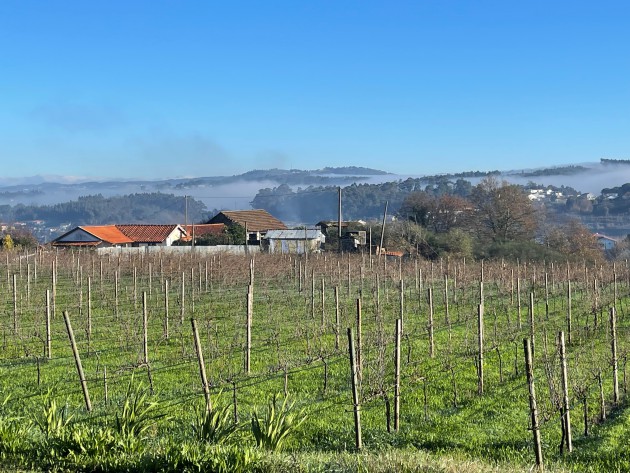
New Vinho Verde project sharpens Alvarinho focus
Portuguese winemaker Luis Cerdeira has left his family’s renowned Soalheiro wine company to establish a new Vinho Verde wine project with his son Manuel, a Plumpton College graduate.
Cerdeira, who built up Soalheiro for more than 30 years, is known for producing diverse and experimental expressions of Alvarinho in its Monçao e Melgaço (MM) heartland, a sub-region of the Vinho Verde, located near the mountainous border with Spain’s Galicia. He has sold his shares in Soalheiro to his mother and sister.
However, Cerdeira said his (as yet not officially named) new project, which includes plans to build a new winery in the village of Melgaço, aims to produce more refined and precise expressions of Alvarinho in MM.
- Read more: Nominations now open for 50 Best Indies
“In Monçao e Melgaço, we are discovering much more by gaining more knowledge about soils and the influence of soils and mountains on vines. There are a variety of soils with different ages, so we will be making more detailed, expressive wines with new dimensions,” Cerdeira told Harpers.
Cerdeira’s move comes amidst a growing investment appetite in the MM sub-region. Having acquired Quinta do Hospital estate in 2017, Falua, owned by the Roullier Group, doubled Alvarinho plantings to 20ha. Over the past two years Symington’s and The Fladgate partnership from the Douro have also acquired historic MM estates. In May 2023, Anselmo Mendes, another leading Alvarinho winemaker, secured a joint venture to produce Alvarinho with Symington Family Estates.
Outside MM, and raising the competitive stakes, Vinho Verde’s biggest producer, Aveleda, has since 2018 invested close to €7m in 85ha of Alvarinho-led plantings on schist soils (hitherto its plantings have been on granitic soils) in a new vineyard located in Cabração, north of Ponte de Lima.
Until 2021 Vinho Verde producers making Alvarinho outside MM sub-region were excluded from using the Vinho Verde DOC appellation and were obliged to use the Regional Minho appellation. Since the implementation of new rules, Aveleda has switched its premium range of wines into the Vinho Verde appellation.
“We’ve made a big bet on Alvarinho,” said Martim Guedes, co-CEO of Quinta da Aveleda, adding that blends would make up an important part of the company’s new wines. Since 2014, Aveleda has tripled its vineyard ownership to about 450ha. “We have bought more vineyards to control the terroir as we invest in our premium wines,” Guedes told Harpers.
Meanwhile Cerdeira said that his new project would go beyond Alvarinho to include the production of blends of Loureiro, Avesso and Arinto. With demand growing for lighter, but fresh, elegant and expressive naturally-balanced wines made from lower yields, Vinho Verde producers including Aphros, Sem Igual, Casa da Paços, Quinta da Santa Teresa and Quinta da Lixa have transformed region with the production of premium white wines and pet-nats.
Alvrinho and Alvarinho-led white wine blends accounted for more than nine million litres of sales between 2000 and 2022. Alvarinho single variety wine sales more than doubled to four million litres during that period, according the Vinho Verde wine board.
Despite the growing premiumisation of Vinho Verde wines, some MM producers fear that blends of Alvarinho will be made across the Vinho Verde at lower prices. This partly explains why winemaker Joana Santiago, owner of Quinta de Santiago, and newly appointed chair of the MM producer association, is this year ramping up moves to create a new MM appellation within the Vinho Verde.
“Only with a DO Monção e Melgaço will we ensure that the value that our region has generated over several decades is not lost in time,” Santiago said.
Anselmo Mendes, who hatched the idea of an appellation said: “A small region like Monção e Melgaço, with around 1,300ha of Alvarinho, has done a lot to promote Portuguese white wines – we have wines for different price segments and we have made the best positioned wines, not only in terms of quality, but also in terms of critics scores, price, presence in international markets, and ageing capacity – many producers have wines that can age up to 20 years. These are important steps to affirm the region as a DO, by having all these things that differentiate it from the rest [of the Vinho Verde].”
“Alvarinho made here has more personality, structure and a sense of place due to its natural conditions,” he added.
However, moves to create an appellation face strong opposition from influential Vinho Verde producers, including Aveleda. “We’re stronger together as a single appellation,” countered Guedes.
Keywords:
- Vinho Verde
- Alvarinho
- Symington
- The Fladgate Partnership
- Portuguese winemaker
- Luis Cerdeira
- Monçao e Melgaço
- Soalheiro




